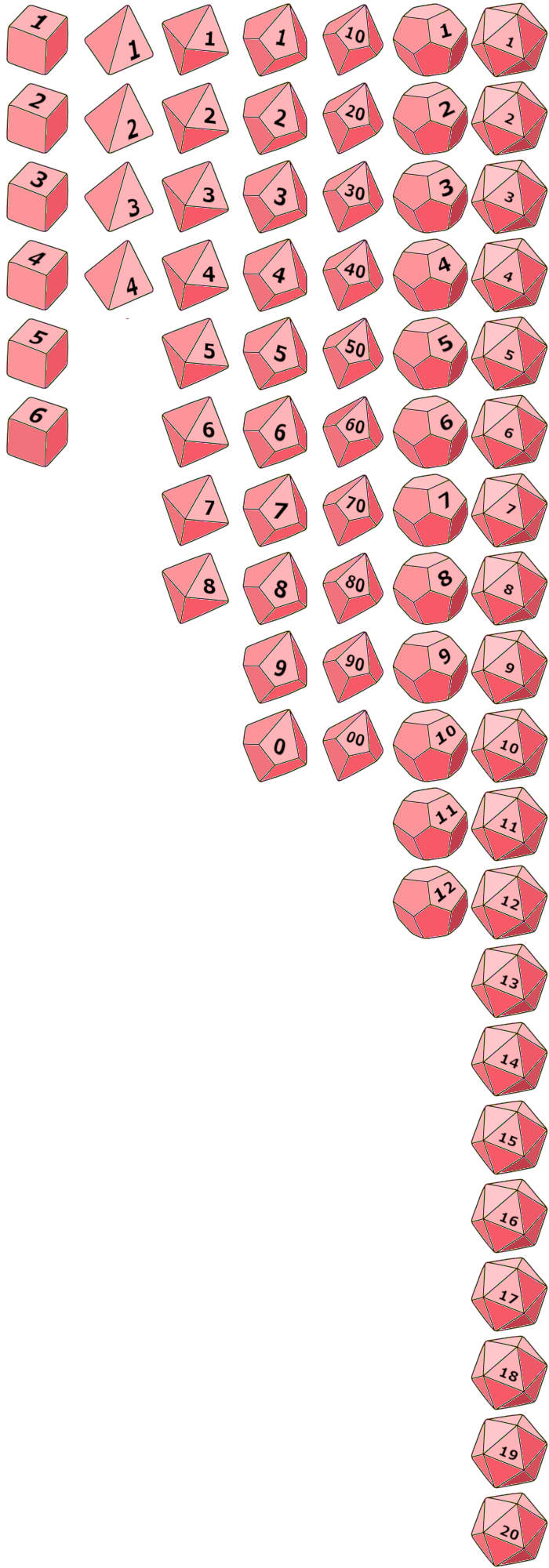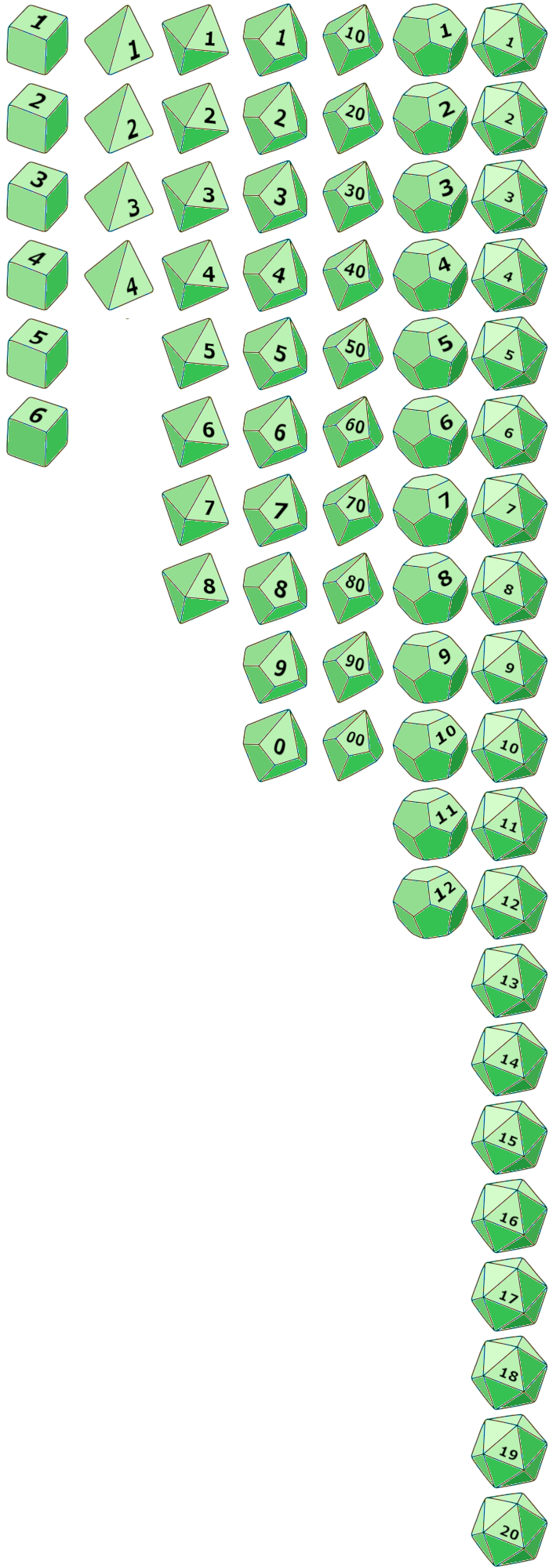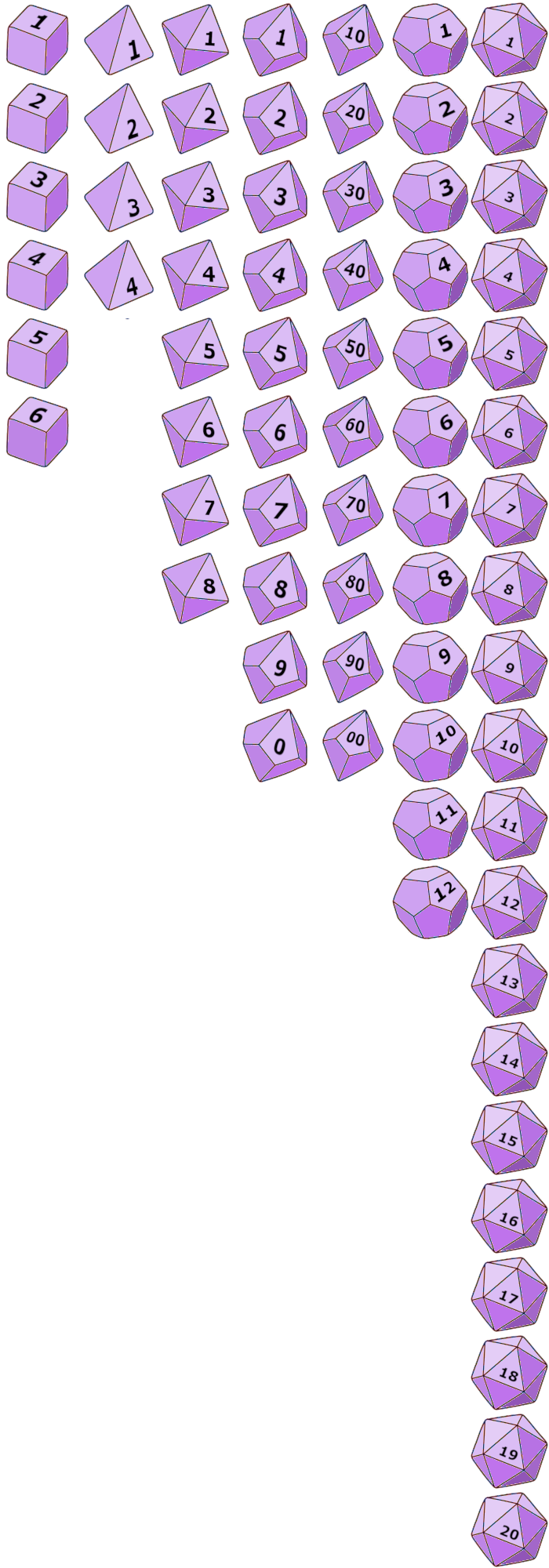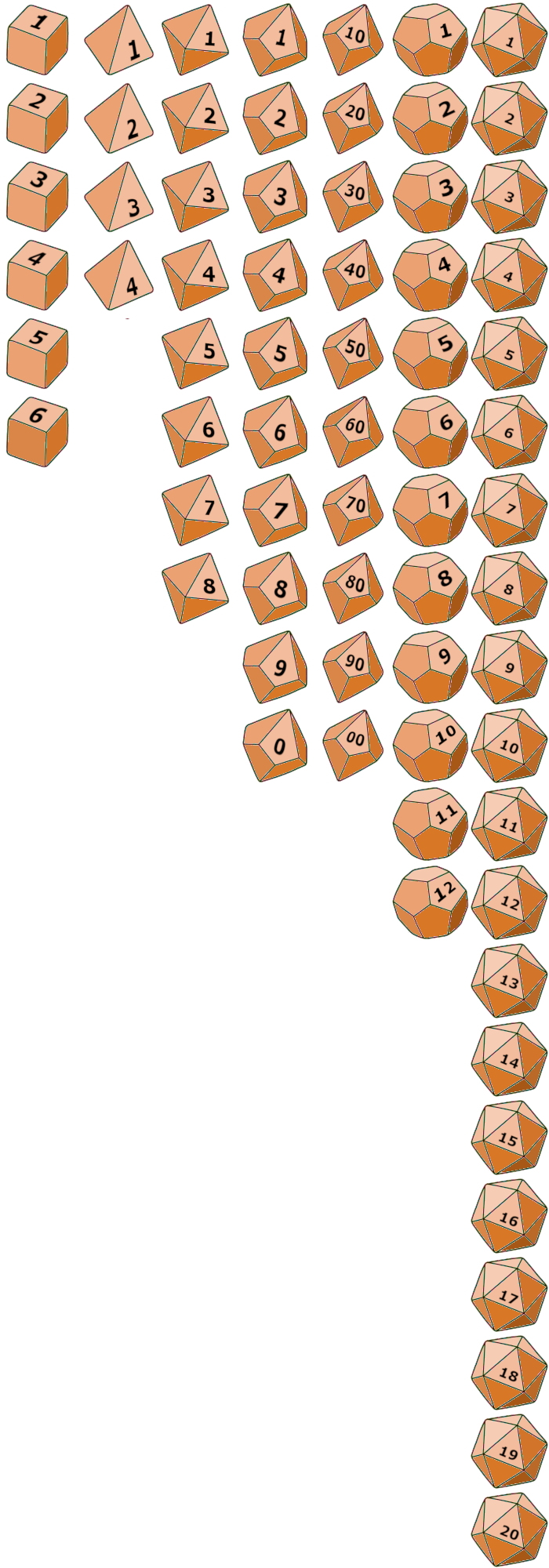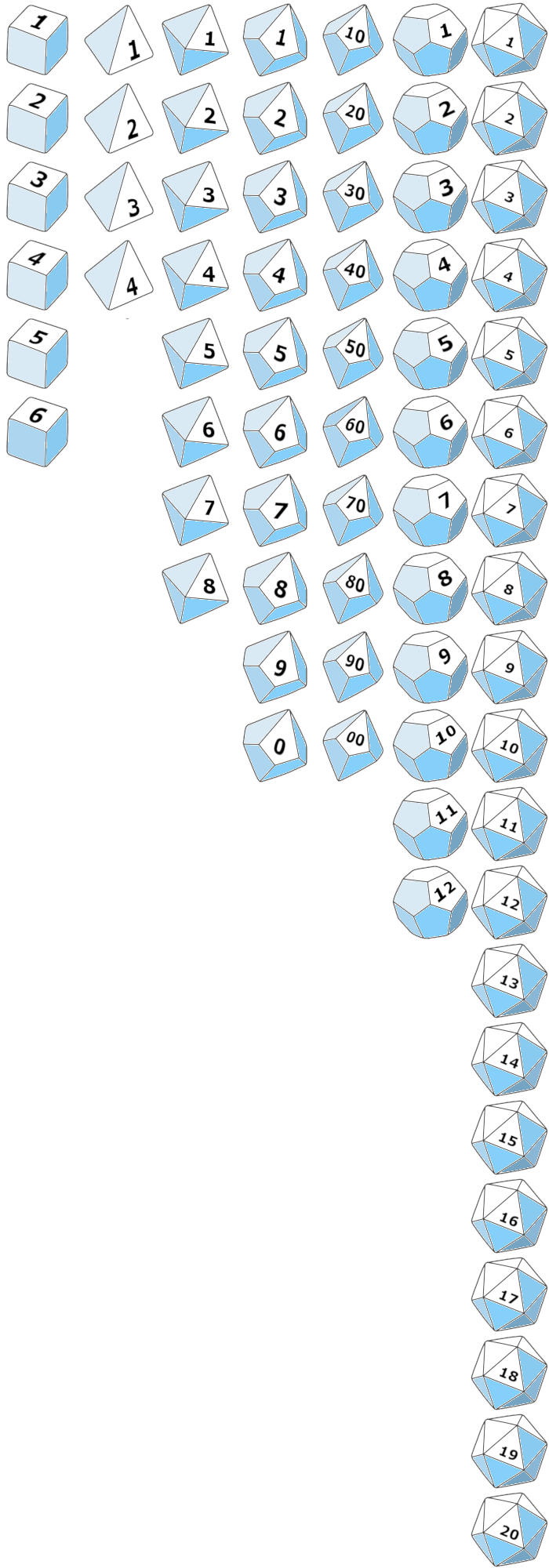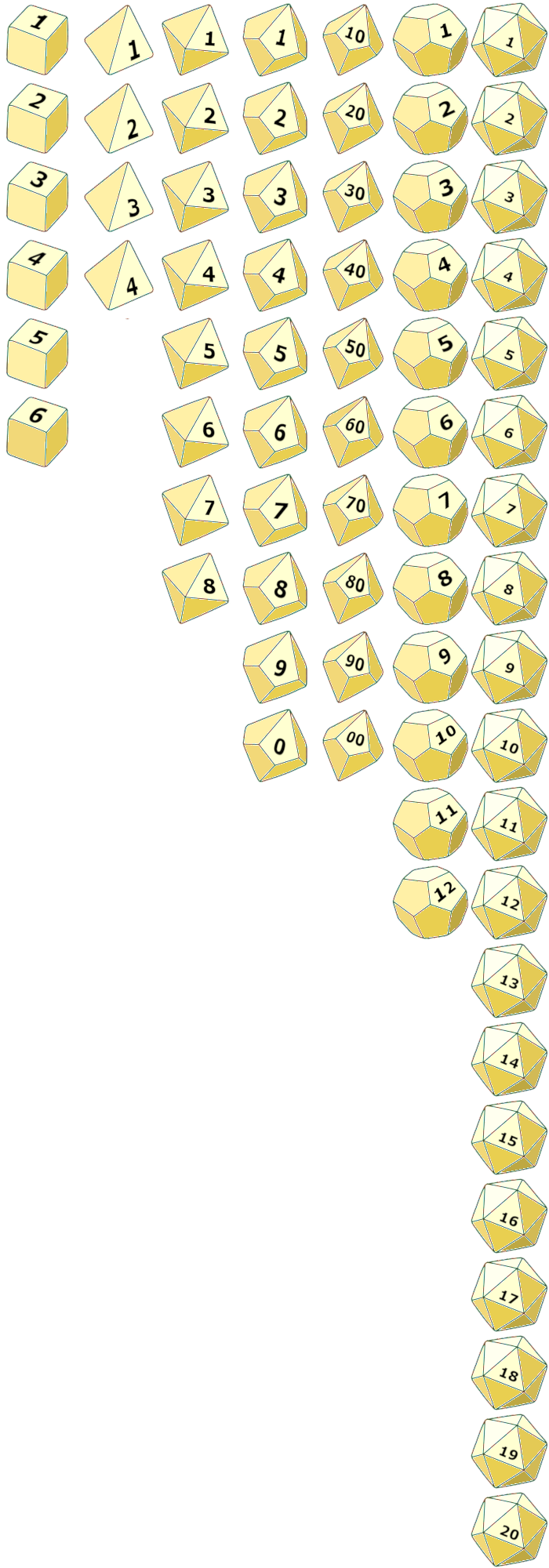Notation du Lanceur de Dés
Over the years role-playing games that use dice have standardized on a
nomenclature for dice in the form
#d#
where the first number is the number dice to roll and the second number
counts the sides on a single die. For example,
3d6
means to roll three, six-sided dice.
Les Dés de Base
There are a standard set of physical dice that are used in many role playing games.
1d4. This pyramid shaped die. The number that is rolled
is read from the base of the die.
1d6. The most common die, the d6 is used in many boardgames
and games of chance.
1d8. This die looks like two pyramids stacked on top of each other.
1d10. This rounded kite-like die often used for percentages.
1d100 or d%. While 100-sided dice exist as novelty items, the
most common way of rolling a d100 is by rolling two dice; onc
is marked with 00, 10, ... 90; the other is marked 0, 1, ... 9.
The range is traditionally 1 to 100. So rolling a 00 and a 1 counts
as a 1, but rolling 00 and a 0 counts as a 100.
1d12. A twelve-sided shape is known as a dodecagon.
1d20. The iconic d20 is the dice made famous by the D&D role-playing
game.
Opérateurs de Dés
How a die roll is calculated can be modifed. The simplest modification is to add a value. For example,
3d6+2
means to roll three, six sided dice and add two to the result for a range of numbers from 5 to 20. The
various modifiers supported by the application are listed below.
!
Explode. Reroll the dice if all the original dice are maximum value. An optional value can be supplied
and the dice are rerolled if they are all greater than or equal to the value.
!!
Explode Until. Same as explode, but keep rolling so long as all dice are maximum values. An optional
value can be supplied and the dice are rerolled if they are all greater than or equal to the value. For example if
2d4!!
results in
4, 4
then the two dice will roll again. If that also results in a
4, 4
then the process continues until something other is rolled.
*
Explode Each. Reroll any die that is the maximum value. An optional
value can be supplied and the die is rerolled if it is greater than or equal to the value. For example,
2d6*: 3,6,5*
where
5
is a bonus roll.
**
Explode Each Until. Same as explode each, but keep rolling so long as the die is a maximum value. An optional
value can be supplied and the die is rerolled if it is greater than or equal to the value.
++
Add Each. Add the given value to each die rolled. If no value is given it is assumed to be 1.
--
Subtract Each. Subtract the given value from each die rolled. If no value is given it is assumed to be 1.
`
Take Low. Given a dice pool, keep the lowest
N
values.
^
Take High. Given a dice pool, keep the highest
N
values. D&D 5 uses
4d6^3
for rolling attributes. Roll four six-sided dice and keep the highest three values.
~
Take Middle. Given a dice pool, keep the middle
N
values. The algorithm has a bias towards keeping the larger value if the middle can not
be determined so
4d6~3
and
4d6^3
are treated the same.
ADV
Advantage. Roll the dice pool twice, keeping the higher pool.
DIS
Disadvantage. Roll the dice pool twice, keeping the lower pool.
Y
Best Group. Keep the largest group of identical values from the pool. Keep the higher value if two groups are the same size. (e.g.
5d6Y: 3,3,4,4,1 = 8
)
Opérateurs Arithmétiques
+
-
Subtraction inverts the values of the dice rolled and applies to both target hits and sums.
For example,
4d6 - 3d4
treats the first four dice as positive and the last three dice as negative. The
+
and
-
operations can be mixed so long as any constant values come last.
Opérateurs de Cible
[]
Target High. Rolls greater then or equal to the given value are hits and are given a value of 1, others are given a value of 0.
(e.g.
3d6[4]: 1,5,4 = 2
).
()
Target Low. Rolls less than or equal to the given value are hits and are given a value of 1, others are given a value of 0.
(e.g.
3d6(3): 1,5,4 = 1
).
{<n>, <m>}
Success. If the total rolled equals or exceeds score 1, adding 1 for each additional
<m>
rolled.
{<n>}
is the same as
{<n>, 1}
Unlike the target operators, this operator is calculated against the complete dice score. This
notation can be used to calculate by how much a roll beat a target number. If the target number
is 10 but the roll is 16 then the value is 7.
